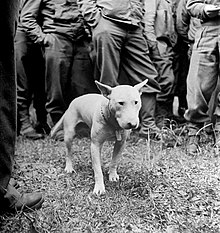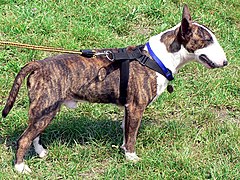Bull Terrier: Difference between revisions
Dwanyewest (talk | contribs) |
No edit summary Tags: Mobile edit Mobile web edit |
||
| Line 1: | Line 1: | ||
{{Bare URLs|date=August 2019}} |
|||
{{Infobox Dog breed |
{{Infobox Dog breed |
||
<!-- Put article text AFTER this infobox markup. See: --> |
<!-- Put article text AFTER this infobox markup. See: --> |
||
Revision as of 17:28, 14 August 2019
| Bull Terrier | |||||||||||||||||||||||||
|---|---|---|---|---|---|---|---|---|---|---|---|---|---|---|---|---|---|---|---|---|---|---|---|---|---|
 | |||||||||||||||||||||||||
| Other names |
| ||||||||||||||||||||||||
| Origin | England | ||||||||||||||||||||||||
| |||||||||||||||||||||||||
| |||||||||||||||||||||||||
| Dog (domestic dog) | |||||||||||||||||||||||||
The Bull Terrier is a breed of dog in the terrier family. There is also a miniature version of this breed which is officially known as the Miniature Bull Terrier.
Appearance

The Bull Terrier's most recognizable feature is its head, described as 'shark-head-shaped' (sometimes confused with egg-shaped) when viewed from the front; the top of the skull is almost flat. The profile curves gently downwards from the top of the skull to the tip of the nose, which is black and bent downwards at the tip, with well-developed nostrils. The lower jaw is deep and strong. The unique triangular eyes are small, dark, and deep-set.[2] Bull Terriers are the only dogs that have triangular eyes. The body is full and round, with strong, muscular shoulders. The tail is carried horizontally. They are either white, red, fawn, black, brindle, or a combination of these.[3]
Temperament
Bull Terriers can be both independent and stubborn[4] and for this reason are not considered suitable for an inexperienced dog owner. A Bull Terrier has an even temperament and is amenable to discipline. Although obstinate, they are particularly good with people.[5] Early socialisation will ensure that the dog will get along with other dogs and animals.[6] Their personality is described as courageous, full of spirit, with a fun-loving attitude,[5] a children-loving dog and a perfect family member. Although the breed has been a target of breed-specific legislation, a 2008 study in Germany didn't find that Bull Terriers have any significant temperament difference from Golden retrievers in overall temperament researches.[7]
Health
All puppies should be checked for deafness, which occurs in 20.4% of pure white Bull Terriers and 1.3% of colored Bull Terriers[8] and is difficult to notice, especially in a relatively young puppy. Many Bull Terriers have a tendency to develop skin allergies.[9] Insect bites, such as those from fleas, and sometimes mosquitoes and mites, can produce a generalised allergic response of hives, rash, and itching. This problem can be stopped by keeping the dog free of contact from these insects, but this is definitely a consideration in climates or circumstances where exposure to these insects is inevitable. A UK breed survey puts their median lifespan at 10 years and their mean at 9 years (1 s.f., RSE = 13.87% 2 d. p.), with a good number of dogs living to 10–15 years.[10]
History


At the start of the 19th century the "Bull and Terrier" breeds were developed to satisfy the needs for vermin control and animal-based blood sports. The Bull and Terriers were based on the Old English Bulldog (now extinct) and Old English Terriers with possible other terriers. This new breed combined the speed and dexterity of lightly built terriers with the dour tenacity of the Bulldog, which was a poor performer in most combat situations, having been bred almost exclusively for fighting bulls and bears tied to a post. Many breeders began to breed bulldogs with terriers, arguing that such a mixture enhances the quality of fighting. Despite the fact that a cross between a bulldog and a terrier was of high value, very little or nothing was done to preserve the breed in its original form. Due to the lack of breed standards—breeding was for performance, not appearance—the "Bull and Terrier" eventually divided into the ancestors of "Bull Terriers" and "Staffordshire Bull Terriers", both smaller and easier to handle than the progenitor.[11]
In the mid-19th century James Hinks started breeding Bull and Terriers with "English White Terriers" (now extinct), looking for a cleaner appearance with better legs and nicer head. In 1862, Hinks entered a dam called "Puss" sired by his white Bulldog called "Madman" into the Bull Terrier Class at the dog show held at the Cremorne Gardens in Chelsea. Originally known as the "Hinks Breed" and "The White Cavalier",[citation needed] these dogs did not yet have the now-familiar "egg face", but kept the stop in the skull profile.[12] The dog was immediately popular and breeding continued, using Dalmatian, Spanish Pointer, and Whippet to increase elegance and agility; and Borzoi and Rough Collie to reduce the stop. Hinks wanted his dogs white, and bred specifically for this. The first modern Bull Terrier is now recognised as "Lord Gladiator", from 1917, being the first dog with no stop at all.[11][13]
Due to medical problems associated with all-white breeding, Ted Lyon among others began introducing colour, using Staffordshire Bull Terriers in the early 20th century. Coloured Bull Terriers were recognised as a separate variety (at least by the AKC) in 1936. Brindle is the preferred colour, but other colours are welcome.[12][14]
Along with conformation, specific behaviour traits were sought. The epithet "White Cavalier",[citation needed] harking back to an age of chivalry, was bestowed on a breed which while never seeking to start a fight was well able to finish one, while socialising well with its "pack", including children and pups. Hinks himself had always aimed at a "gentleman's companion"[citation needed] dog rather than a pit-fighter—though Bullies were often entered in the pits, with some success.
- Bull Terrier
-
With a Miniature Bull Terrier
-
Brindle and white Bull Terrier
-
White Bull Terrier
-
Red and white Bull Terrier
-
Modern-colored Bull Terrier
In popular culture
This section gives self-sourcing popular culture examples. (June 2019) |

- General George S. Patton owned a Bull Terrier named Willie,[15] and a portrayal of him is featured in the 1970 movie Patton.
- In Charles Dickens' Oliver Twist (1838), Bill Sikes's dog Bull's-eye is a Bull Terrier.
- In Ernest Thompson Seton's book Animal Heroes (1905) there is a story Snap about a fearless Bull Terrier named Gingersnap which helps North Dakota ranchers to kill wolves.
- In the TV show Baa Baa Black Sheep Major Gregory Boyington, owns a Bull Terrier named "Meatball" which also serves as the squadron mascot for VMF-214.
- A Bull Terrier named Wildfire is the narrator of and a character in MGM's 1955 film It's a Dog's Life.
- Spuds MacKenzie is a fictional dog character created for use in an extensive advertising campaign marketing Bud Light beer in the late 1980s.
- The New Yorker cartoonist George Booth drew what he "thought looked like a mean dog", and after a fan asked if it represented "an English Bull Terrier", he researched the breed's appearance and made his further versions of it a mainstay of his cartoons.[16]
- A picture of a Bull Terrier named Nelson became an Internet meme in late 2018 for its evocative face.[17]
See also
References
- ^ a b "Bull Terrier Dog Breed Information, Pictures, Characteristics & Facts - Dogtime". Archived from the original on 2016-10-30.
{{cite web}}: Unknown parameter|deadurl=ignored (|url-status=suggested) (help) - ^ https://archive.org/details/dogsofallnations00masorich/page/18
- ^ CKC Breed Standards, ckc.ca, archived at the Wayback Machine, 20 February 2008.
- ^ Breeder Retriever. "Bull Terrier Temperament". Archived from the original on 2012-02-03.
{{cite web}}: Unknown parameter|deadurl=ignored (|url-status=suggested) (help) - ^ a b "BREED STANDARD - The Bull Terrier Club". Archived from the original on 2015-11-20.
{{cite web}}: Unknown parameter|deadurl=ignored (|url-status=suggested) (help) - ^ "ADBA American Pit Bull Terrier Puppy Socialization". adbadog.com. 8 February 2018. Archived from the original on 30 July 2017.
{{cite web}}: Unknown parameter|deadurl=ignored (|url-status=suggested) (help) - ^ Ott, Stefanie A.; Schalke, Esther; von Gaertner, Amelie M.; Hackbarth, Hansjoachim (May - June 2008). "Is there a difference? Comparison of golden retrievers and dogs affected by breed-specific legislation regarding aggressive behavior". Journal of Veterinary Behavior. Volume 3, Issue 3, Elsevier Inc. pp. 134–140
- ^ Breed-Specific Deafness Prevalence In Dogs (percent) Archived 2013-01-28 at the Wayback Machine. LSU.edu
- ^ Richards, Michael. Skin Disorders and Problems of Dogs Archived 2007-11-20 at the Wayback Machine, vetinfo4dogs.com
- ^ "Individual Breed Results for Purebred Dog Health Survey". Archived from the original on 2007-05-04.
{{cite web}}: Unknown parameter|deadurl=ignored (|url-status=suggested) (help) - ^ a b "Canterbury Bull Terrier Club". 21 November 2008. Archived from the original on 21 November 2008.
{{cite web}}: Unknown parameter|dead-url=ignored (|url-status=suggested) (help) - ^ a b American Kennel Club:Bull Terrier History Archived 2015-08-05 at the Wayback Machine, akc.org
- ^ ANKC: Extended Breed Standard of The Bull Terrier & Bull Terrier (Miniature) Archived July 22, 2008, at the Wayback Machine, ankc.org.au
- ^ T.W. Hogarth published The Coloured and Colour Breeding, Galashiels: A Walker & Son in 1932, which included chapters – 'Colour Breeding in Bull Terriers' by Major T Grahame and Captain J.N. Ritchie and 'Colour Inheritance in Bull-terriers' by Dr F Fraser Darling.
- ^ Amanda Macias, "This photo shows Gen. Patton's dog Willie after the general's death" Archived 2016-04-10 at the Wayback Machine, Business Insider, Dec. 21, 2015, 6:29 PM,
- ^ CAROL STRICKLAND, "Flights of Lunacy on the Drawing Board" Archived 2016-12-20 at the Wayback Machine, New York Times, February 7, 1993
- ^ KnowYourMeme.com, "Nelson the Bull Terrier"





